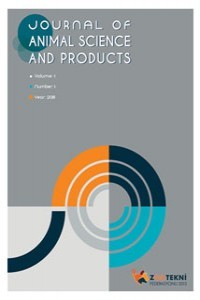Yapağı Kalitesini Etkileyen Genetik ve Çevresel Faktörler ile Yapağıların Kullanım Alanlarına Genel Bakış
Günümüzde dünya genelinde çok çeşitli koyun ırkları bulunmakla beraber, tekstil endüstrisinin kullandığı kaliteli yün, merinos ırkından gelmektedir. Merinos yününün kalitesi, bu yünlerin fabrikada göreceği işlemlerdeki iş akışını ve yünün işleme verimliliğini etkilemektedir. Ayrıca nihai ürünlerin kalitesi ve potansiyel kullanım alanı lifin kalitesi tarafından belirlenmektedir. Bir koyunun üreteceği yapağı miktarı ve kalitesini etkileyen faktörler genetik etkiler ile fizyolojik ve çevresel etkiler olmak üzere iki ana başlık altında incelenebilir. Bu derleme makalede yapağı kalitesini etkileyen faktörler ve yün liflerinin kullanım alanları hakkında genel bilgi verilmektedir.
Anahtar Kelimeler:
Merinos, yün, lif kalitesi, genetik etki, çevresel etki
An Overview of Genetic and Environmental Factors Affecting Wool Quality and the Usage Areas of Wool
Although there are a wide variety of sheep breeds around the world today, the quality wool used by the textile industry comes from the Merino breed. The quality of Merino wool affects the workflow and processing efficiency of the wool in the processes that these wools will be subjected in the factory. In addition, the quality of the final products and their potential use are determined by the quality of the fiber. The factors affecting the amount and quality of wool fiber produced by a sheep can be examined under two main headings as genetic effects and physiological and environmental effects. In this review article, general information about the factors affecting the quality of the fleece and the usage areas of wool fibers is given.
Keywords:
Merino, Wool, Fiber quality, Genetic effect, Environmental effect,
___
- Anonim. (2019). Notes on Sheep Shearing and Maintaining the Quality of Fleeces.
- Anonim. (2020a). Erişim Adresi: https://www.commonobjective.co/article/global-wool-production-and-sustainable-standards. Erişim Tarihi: 13.09.2021.
- Anonim. (2020b). Erişim Adresi: https://www.awe.gov.au/news/media-releases/woolpoll-review-final-report-now-available. Erişim Tarihi: 13.09.2021.
- Anonim. (2020c). Erişim Adresi: https://www.persistencemarketresearch.com/market-research/wool-market.asp. Erişim Tarihi: 13.09.2021.
- Anonim. (2020d). BestWool/BestLamb: Active participation.
- Anonim. (2021a). Erişim Adresi: http://www.sheepcover.com/sheepcover/index.html, Erişim Tarihi: 27.11.2021
- Anonim. (2021b). Erişim Adresi: https://sheepgal.typepad.com/sheepgal_notes_from_a_she/2011/01/new-sheep-suits.html. Erişim Tarihi: 28.09.2021.
- Anonim. (2022a). https://acikders.ankara.edu.tr, Erişim Tarihi: 14.11.2022
- Anonim. (2022b). Erişim Adresi: https://tr.wikipedia.org/wiki/Y%C3%BCn
- AWI. (2020). Wool 2030: A strategic plan for Australian wool growers. Discussion paper 1: wool supply and demand.
- Bradford, G.E., ve Spurlock, G.M. (1964). Effects of castrating lambs on growth and body composition. Animal Production, 6(3), 291–299.
- Doyle, E.K., Preston, J.W.V., McGregor, B.A., ve Hynd, P.I. (2021). The science behind the wool industry: The importance and value of wool production from sheep. Animal Frontiers, 11(2), 15-23.
- Faostat. (2021). Erişim Adresi: https://www.fao.org/faostat/en/#data, Erişim Tarihi:16.01.2023
- Hather, S., Atkins, K.D., ve Thornberry, K.J. (2003). Sheep coats can economically improve the style of western fine wools. Australian Journal of Experimental Agriculture, 43, 53-59.
- Hather, S., Atkins, K.D., ve Thornberry, K.J. (2008). Strategic use of sheep coats can improve your economic return. Australian Journal of Experimental Agriculture, 48, 762-767.
- Hinch, G. (2013). Lecture 5: Managing Weaners and Breeding Ewes for Wool Production.
- Hopkins, D.L., Jackson, R.B., ve Roberts, A.H.K. (1992). Comparison of a modified cryptorchid treatment and castration: effect on growth, wool production, posthitis, testosterone production and development of masculine characteristics. Australian Journal of Experimental Agriculture. 32(4), 443-446.
- Hutu, I. (2015) Farm Animal Productions a course for animal productions and husbandry, Editura MIRTON Timișoara - TM, Romamia & TVT Publishing, River Falls - WI, SUA
- Khan, M.J., Abbas, A., Ayaz, M., Naeem, M., Akhter, M.S., ve Soomro, M.H. (2012). Factors affecting wool quality and quantity in sheep. African Journal of Biotechnology, 11(73), 13761-13766.
- Mortimer, S. (2017). Wool colour and fleece rot. Woolwise (böl. 4).
- Nazari-Zonouz, F., Moghaddam, G., Rafat, S.A., Abdi, Z., Etemad Gorgan, K., ve Nabavi, R. (2018). The Effect of Prepubertal Castration on Wool Diameter and Blood Testosterone in Ghezel Breed. Iranian Journal of Applied Animal Science. 8(4), 635-639.
- Richards, J.S., ve Atkins, K.D. (2005). The role of selected wether flocks in merıno wool enterprises. Association for the Advancement of Animal Breeding and Genetics, 16, 223-226.
- Scobie, D.R., Grosvenor, A.J., Bray, A.R., Tandon, S.K., Meade, W.J., ve Cooper, A.M.B. (2015). A review of wool fibre variation across the body of sheep and the effects an wool processing. Small Ruminant Research, 133, 43–53.
- Simm, G., Pollott, G., Mrode, R., Houston, R., ve Marshall, K. (2022). Çiftlik hayvanlarının genetik ıslahı. M. İhsan Soysal (Ed.). Ankara, Türkiye: Nobel Akademik Yayıncılık.
- Soysal, İ.M., ve Özkan Ünal, E. (19 Nisan, 2019). Sheep Breeds Genetic Diversity of Farm Animal Genetic Resourches of Türkiye. 2019 International Congress on Wool and Luxury Fibres (ICONWOOLF). Bildiri (Tam Metin), 11-18.
- Tarakçıoğlu, I. (1983). Yumurta akı (protein) liflerinin terbiyesi. Tekstil Terbiyesi ve Makinaları (C 2). Bursa, Türkiye: Uludağ Üniversitesi Yayınları.
- Textile Exchange. (2020). Preferred Fiber & Materials 2020 Market Report.
- Yüksel, B. (1986). Ştrayhgarn ve Kamgarn Yün iplikçiliği. Werner von Berhen (ed.). Türkiye: İstanbul: İTÜ Matbaası.
- Yayın Aralığı: Yılda 2 Sayı
- Başlangıç: 2018
- Yayıncı: Zootekni Federasyonu (ZF)
Sayıdaki Diğer Makaleler
Riza ATAV, Bürhan BUĞDAYCI, M.ihsan SOYSAL
Saif Adil Abbood AL-JANABI, Mehmet Ulaş ÇINAR, Ghulam Asghar SAJİD, Ahmed Qasim Naji NAJİ, Md Mahmodul Hasan SOHEL
Süt Sığırlarında Uzun Ömürlülük (Longevity) Ölçüleri
Yerli Keçi Sütünün Besin Bileşimi ve Kalitesi ile Kırsal Toplumların Protein Beslenmesine Katkısı
Rutendo MAGAYA, Tonderai MUTİBVU, David MBİRİRİ
Ferhat DEMİR, Zihni Serbay SANDALCIOĞLU, Cengiz ERKAN
Dünya Merinos Irkları ve Bunların Genel Özellikleri
Bürhan BUĞDAYCI, Riza ATAV, M.ihsan SOYSAL
Hidroponik Sistemle Üretilen Bazı Yem Bitkilerinin Ruminant Hayvan Beslemesinde Kullanımı
